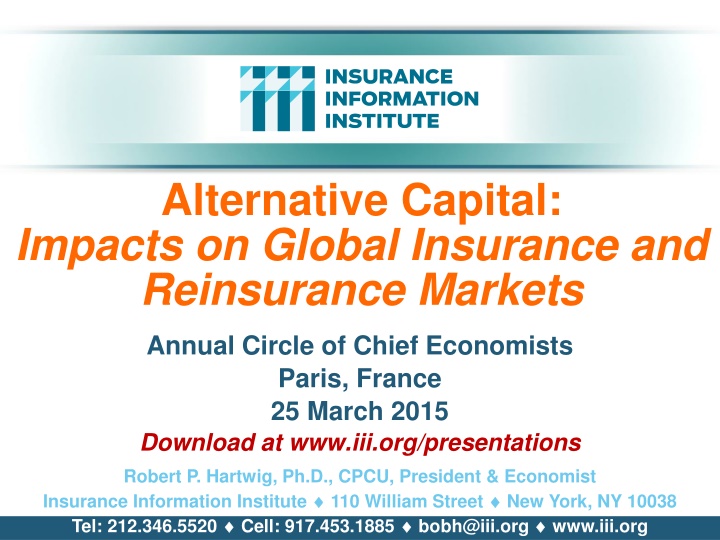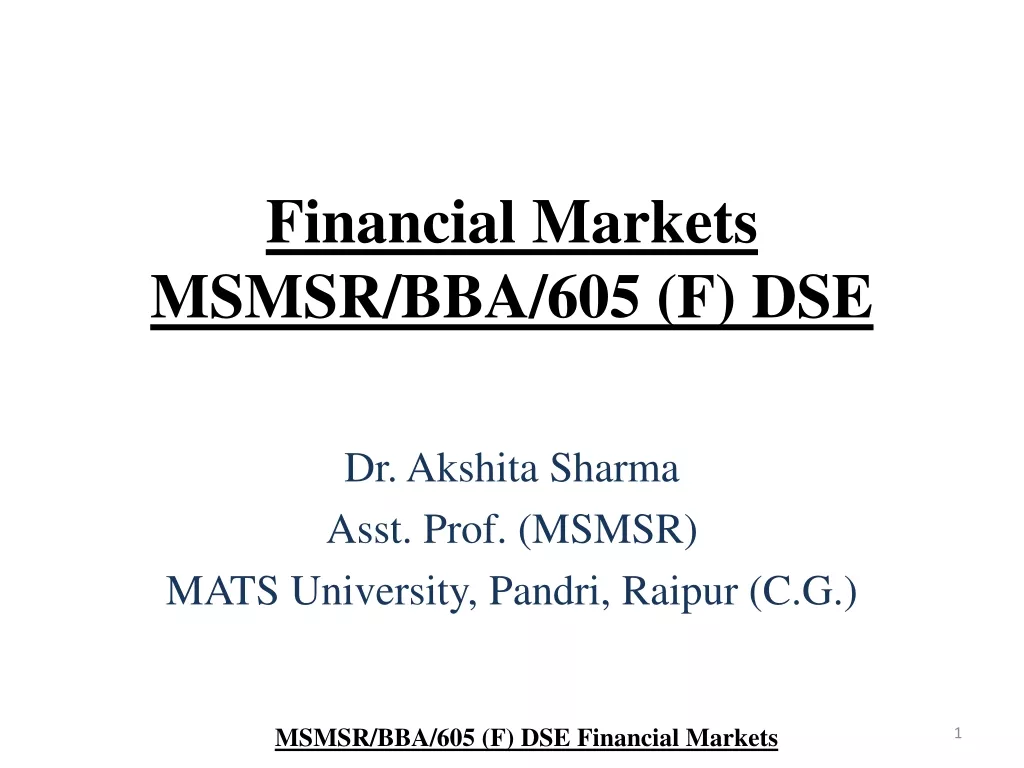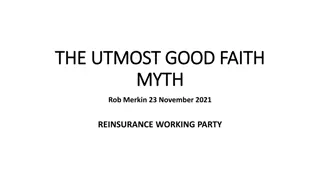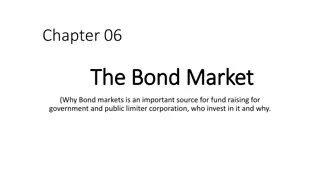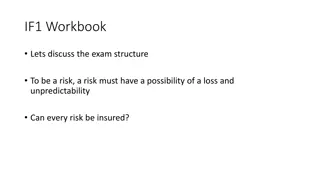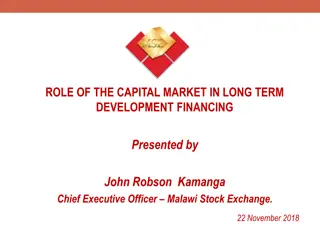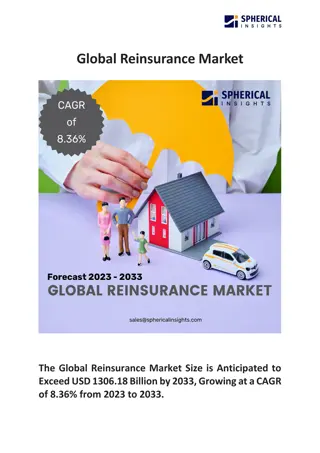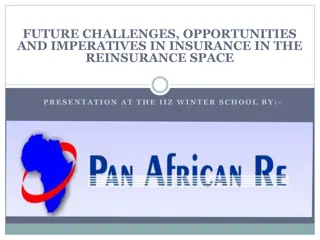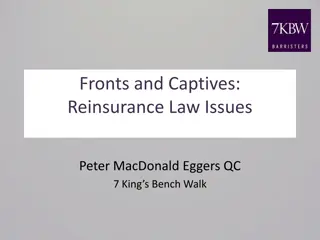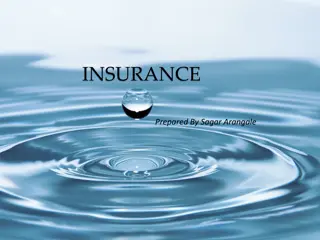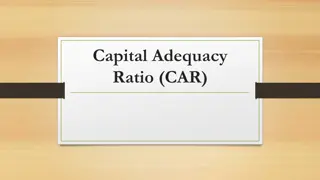Global Impacts of Alternative Capital on Insurance and Reinsurance Markets
The presentation discusses the influence of alternative capital on global insurance and reinsurance markets, highlighting the shift in seeking higher returns due to low yields in capital markets. It delves into the trends of U.S. Treasury security yields, European Central Bank benchmark rates, book yields on P/C insurance invested assets, and the abundance of capital in the hedge fund industry. The data presented indicates a significant impact on investment strategies and market dynamics within the insurance and reinsurance sectors.
Download Presentation

Please find below an Image/Link to download the presentation.
The content on the website is provided AS IS for your information and personal use only. It may not be sold, licensed, or shared on other websites without obtaining consent from the author.If you encounter any issues during the download, it is possible that the publisher has removed the file from their server.
You are allowed to download the files provided on this website for personal or commercial use, subject to the condition that they are used lawfully. All files are the property of their respective owners.
The content on the website is provided AS IS for your information and personal use only. It may not be sold, licensed, or shared on other websites without obtaining consent from the author.
E N D
Presentation Transcript
Alternative Capital: Impacts on Global Insurance and Reinsurance Markets Annual Circle of Chief Economists Paris, France 25 March 2015 Download at www.iii.org/presentations Robert P. Hartwig, Ph.D., CPCU, President & Economist Insurance Information Institute 110 William Street New York, NY 10038 Tel: 212.346.5520 Cell: 917.453.1885 bobh@iii.org www.iii.org
A World of Low Yields Capital Will Seek Its Highest (Risk-Adjusted) Return 2 2
U.S. Treasury Security Yields: A Long Downward Trend, 1990 2015* 9% Yields on 10-Year U.S. Treasury Notes have been essentially below 5% for a full decade. U.S. Treasury yields plunged to historic lows in 2013. Longer- term yields rebounded then sank fell again. 8% 7% 6% 5% 4% 3% 2% Recession 2-Yr Yield 10-Yr Yield 1% 0% '90 '91 '92 '93 '94 '95 '96 '97 '98 '99 '00 '01 '02 '03 '04 '05 '06 '07 '08 '09 '10 '11 '12 '13 '14 '15 Since roughly 80% of P/C bond/cash investments are in 10-year or shorter durations, most P/C insurer portfolios will have low-yielding bonds for years to come. *Monthly, constant maturity, nominal rates, through Feb. 2015. Sources: Federal Reserve Bank at http://www.federalreserve.gov/releases/h15/data.htm. National Bureau of Economic Research (recession dates); Insurance Information Institute. 3 3
European Central Bank Benchmark Rate, 2000 2015* ECB s cut its key rate to 0.05% on 4 Sept. 2014 where it remains in March 2015 Interest Rates Have Been Slashed by Most Major Central Banks, Igniting a Global Quest for Yield. Reinsurance Is Just One of Many New Areas Discovered by Large Institutional Investors *As of 20 March 2015. Source: European Central Bank from www.tradingeconomics.com; Insurance Information Institute. 4
Book Yield on Property/Casualty Insurance Invested Assets, 2007 2016F (Percent) 4.6 Book yield in 2014 is down 114 BP from pre-crisis levels 4.42 4.4 4.19 4.2 3.95 4.0 3.74 3.71 3.8 3.52 3.6 3.38 3.4 3.28 3.20 3.13 3.2 3.0 07 08 09 10 11 12 13 14E 15F 16F The yield on invested assets continues to decline as returns on maturing bonds generally still exceed new money yields. The end of the Fed s QE program in Oct. 2014 should allow some increase in longer maturities while short term interest rate increases are unlikely until mid-to-late 2015 Sources: Conning.
A World Awash in Capital Too Much of a Good Thing? The Global Glut of Capital is Not Unique to (Re)Insurance 6 6
Hedge Fund Industry: Assets Under Management: 1997 2014:Q41 ($ Billions) $3,000 $2,478.6 $2,156.7 $2,136.8 $2,500 $1,798.7 $1,713.1 $1,710.0 $1,693.9 $1,554.1 $1,457.9 $2,000 $1,360.7 $1,229.0 $1,500 $825.6 $1,000 Assets managed by hedge funds are up 70% or $1.02 trillion since 2008 to $2.48 trillion $505.5 $321.9 $236.6 $188.9 $143.1 $118.2 $500 $0 97 98 99 00 01 02 03 04 05 06 07 08 09 10 11 12 13 14:Q4 Yield Hungry Pension Funds Have Grown Rapidly Since the Financial Crisis, Deploying Oceans of Capital in Industries Across the Globe Including the Global Reinsurance Industry 1 Figures for 2011-2014 are as of Q4 for each year. Sources: BarclayHedge: http://www.barclayhedge.com/research/indices/ghs/mum/Hedge_Fund.html; Insurance Information Institute.
S&P 500 (Excl. Financials): Cash & Short-Term Investments Cash and ST investments holdings have nearly doubled since 2007 Holdings of Cash and Liquid Asset Holdings Have Soared Across Virtually All Industries Since the Financial Crisis Source: Fact Set Fundamentals. 8
Global Pension Assets Growth, 2008 2013* Global pension assets for the top 13 pension markets reached $31.98 trillion in 2013 (+9.5% from 2012), an amount equal to 83.4% of these economies Compound Annual Growth Rate (%) CAGR of pension fund assets in most major pension markets has been quite strong since the financial crisis 16% 14.9% 13.3% 14% 11.4% 10.6% 12% 10.1% 9.9% 8.6% 8.4% 10% 8.0% 8% 6.4% 5.5% 6% 4.4% 4% 2.3% 2% 0% UK South Africa US Japan Ireland Brazil Canada Germany France Australia Switzerland Hong Kong Netherlands *As of year-end. Source: Towers Watson Global Pensions Asset Study 2014 at: http://www.towerswatson.com/en-US/Insights/IC-Types/Survey- Research-Results/2014/02/Global-Pensions-Asset-Study-2014 9 9
Pension Asset Allocation (World s 7 Largest Pension Markets) Alternative investment s share of assets is up +15 points since 2001 from 5% to 18% Holdings of Cash and Liquid Asset Holdings Have Soared Across Virtually All Industries Since the Financial Crisis *Australia, Canada, Japan, Netherlands, Switzerland, UK, US. Source: Towers Watson Global Pensions Asset Study 2014 at: http://www.towerswatson.com/en-US/Insights/IC-Types/Survey- Research-Results/2014/02/Global-Pensions-Asset-Study-2014 10
Policyholder Surplus, 2006:Q4 2014:Q3 ($ Billions) $700 Drop due to near-record 2011 CAT losses 2007:Q3 Pre-Crisis Peak $673.9 $671.6 $662.0 $653.3 $624.4 $650 $614.0 $607.7 $586.9 $583.5 $566.5 $600 $570.7 $567.8 $559.2 $559.1 $550.3 $544.8 $540.7 $538.6 $530.5 $550 $521.8 $517.9 $515.6 $512.8 $511.5 $505.0 $496.6 $490.8 $487.1 $478.5 $500 $463.0 $455.6 Surplus as of 9/30/14 stood at a record high $673.9B $437.1 $450 $400 06:Q4 07:Q1 07:Q2 07:Q3 07:Q4 08:Q1 08:Q2 08:Q3 08:Q4 09:Q1 09:Q2 09:Q3 09:Q4 10:Q1 10:Q2 10:Q3 10:Q4 11:Q1 11:Q2 11:Q3 11:Q4 12:Q1 12:Q2 12:Q3 12:Q4 13:Q1 13:Q2 13:Q3 13:Q4 14:Q1 14:Q2 14:Q3 The industry now has $1 of surplus for every $0.73 of NPW, close to the strongest claims-paying status in its history. 2010:Q1 data includes $22.5B of paid-in capital from a holding company parent for one insurer s investment in a non-insurance business . The P/C insurance industry entered 2015 in very strong financial condition. Sources: ISO, A.M .Best. 11
Premium-to-Surplus Ratio: 1985 2014* (Ratio of NWP to PHS) The larger surplus is in relation to premiums the lower the P:S ratio and the great the industry s capacity to handle the risk it has accepted $2.00 $1.90 $1.80 $1.70 $1.60 Surplus as of 9/30/14 was $0.75:$1, a near-record low (at least in modern history) $1.50 $1.40 $1.30 $1.20 $1.10 $1.00 $0.90 $0.80 9/11, Recession & Hard Market $0.70 $0.60 $0.50 85 86 87 88 89 90 91 92 93 94 95 96 97 98 99 00 01 02 03 04 05 06 07 08 09 10 11 12 13 14* The Premium-to-Surplus Ratio Stood at $0.75:$1 as of 9/30/14, a Record Low (at Least in Recent History) * As of 9/30/14. Source: A.M. Best, ISO, Insurance Information Institute.
US P/C Insurance Industry Excess Capital Position: 1994 2016E Barclay s suggests that surplus is approximately $200B (~30%) Surplus Redundancy (Deficiency) Percent Redundancy (Deficiency) The Industry s Strong Capital Position Suggests Insurers Are in a Good Position to Increase Risk Appetite, Repurchase Shares and Pursue Acquisitions Source: Barclays Research estimates.
Alternative Capital New Investors Continue to Change the Reinsurance Landscape First I.I.I. White Paper Released in March 2015 15 15
Global Reinsurance Capital (Traditional and Alternative), 2006 - 2014 Total reinsurance capital reached a record $570B in 2013, up 68% from 2008. But alternative capacity has grown 210% since 2008, to $50B. It has more than doubled in the past three years. 2014 data is as of June 30, 2014. Source: Aon Benfield Analytics; Insurance Information Institute.
Increase in Global Reinsurance Capital, 2008 2014:Q4 Alternative Capital Growth Facts 2014, $Billions Reinsurance capital increased by ~$230 Bill. from 2008 - 2014 All Other $192 Bill Alternative capital s growth rate was 25% in 2014, 28% in 2013 and 39% in 2012. Alternative capital s share of global reinsurance capital has doubled, from 5.9% in 2008 to 12.0% in 2014 17% Alternative Capital $40 Bill 83% This growth has occurred during a period of falling and very low interest rates and, with the exception of 2011, relatively benign global cat activity. Alternative Capital now accounts for about 17% of global reinsurance capital Source: Insurance Information Institute based on data from Aon Benfield. 17
Alternative Capital as a Percentage of Traditional Global Reinsurance Capital 12.0% 12% 10.2% 10% 8.4% 8% 6.5% 5.9% 5.8% 5.7% 5.4% 6% 4.6% 4% 2% 0% 2006 2007 2008 2009 2010 2011 2012 2013 2014 Alternative Capital s Share of Global Reinsurance Capital Has More Than Doubled Since 2010. 2014 data is as of September 30, 2014. Source: Aon Benfield Analytics; Insurance Information Institute.
Growth of Alternative Capital Structures, 2002 - 2014 Collateralized Re s Growth Has Accelerated in the Past Three Years. Collateralized Reinsurance and Catastrophe Bonds Currently Dominate the Alternative Capital Market. 2014 data is as of June 30, 2014. Source: Aon Benfield Analytics; Insurance Information Institute.
Catastrophe Bond Issuance and Outstanding: 1997-2014 Risk Capital Amount ($ Millions) 2014 Has Seen the Largest Cat Bond Ever - $1.5 Billion (Florida Citizens). Bond Issuance Set a Record. Source: Guy Carpenter. 20
Largest Sponsors of ILS, Year-End 2014 Two of the Largest ILS Issuers Are Government-Sponsored Insurers. Nine Government-Related Insurers Have $4.6 Billion in Outstanding Securities. Source: Artemis.bm; Insurance Information Institute. 21
Reinsurance Pricing: Change in Rate on Line for Cat Business Alternative Capital, Low Levels of Catastrophe Drive Rates Down. 76% 2006: Higher Rates After Record Hurricanes. (Change from Previous Year) 2001-02: WTC Losses, Falling Stock, Bond Prices Dry Up Capital. 40% Japan, NZ Quakes, US Tornadoes. 30% 20% 14% 14% 10% 7% 10% 0% -3% -6% -10% -7% -9% -11% -11% -12% -16% -20% -17% 2002 2003 2004 2005 2006 2007 2008 2009 2010 2011 2012 2013 2014 2015 Catastrophe Reinsurance Prices Fell 11 Percent on January 1 Renewals, Driven by Emergence of New Capital, Mild Catastrophe Losses. 2014 reflects change through June 30 from prior year end. 2015 is for January 1 renewals.. Source: Guy Carpenter; Insurance Information Institute.
U.S. Wind-Exposed Risk Premium* 2010:Q1 to 2014:Q4 Risk spreads rose in 2011- 2012 from cat activity and changes to catastrophe models. Risk spreads dropped to less than half their mid-2012 levels equivalent to lower rates low cat losses, capital entering market. 13.0% Risk Spread (coupon risk-free rate) 12.0% 12.0% 11.6% 10.9% 11.0% 11.0% 12.0% 10.0% 10.9% 10.1% 9.0% 8.2% 7.6% 8.0% 8.2% 8.0% 7.9% 8.2% 7.0% 8.0% 7.4% 7.2% 6.1% 6.4% 6.0% 6.2% 5.8% 5.0% * Trailing 12-month average SOURCE: Willis Capital Markets, Insurance Information Institute. 23
Non-U.S. Wind-Exposed Risk Premium* 2010:Q1-2014: Q1 Spreads are also falling in non-U.S. wind exposures, but less sharply and in line with expected losses 10.0% Risk Spread (coupon risk-free rate) 9.0% 8.5% 8.0% 7.2% 6.9% 7.0% 6.0% 5.6% 4.2% 5.4% 4.9% 4.8% 5.7% 5.0% 5.7%5.7% 4.2% 4.5% 4.0% 3.6% 4.2% 2.7%2.6% 3.0% Wtd. Avg. Risk Spread 2.0% * Trailing 12-month average. SOURCE: Willis Capital Markets, Insurance Information Institute. 24
Insurance-Linked Securities: Average Multiples, 1997 2014* In Early Years, Investor Reluctance Kept Multiples High in Tiny Market 8 Risk Spread/Expected Loss 7 7.22 6 6.51 2014: Breaking 2013 Record for Lowest Multiple 5.90 5.675.38 5 5.42 5.14 4 4.56 4.154.44 4.33 4.29 3.70 Multiple is a Rough Estimate of Risk- Adjusted Return 3 3.39 3.33 3.23 3.14 2.78 2 Range Established 1 0 Cat Bond Terms Have Also Softened, With Indemnity Triggers (Favored by Insurers) Growing More Common. *The ILS Multiple is computed as: (Bond Coupon Risk Free Yield)/Expected Loss. SOURCE: www.Artemis.bm Deal Directory, Insurance Information Institute. 25
ILS Issuance by Trigger Terms Are Shifting Away From Objective Triggers (Favored by Investors) Toward Indemnity Trigger (Favored by Insurers). Source: Artemis.bm; Insurance Information Institute.
Catastrophe Bonds Outstanding, Q4 2014 U.S. Wind and Quake 33% Catastrophe Bonds Are Heavily Concentrated in U.S. Hurricane Exposures. Two- thirds of Catastrophe Risks Outstanding Cover U.S. Wind Risks. Japanese Perils 8% U.S. Wind 25% Other (ex. U.S. Wind) 8% U.S. Quake 8% Euro Wind 9% Other (incl. U.S. Wind) 9% Source: Willis Capital Markets, Insurance Information Institute. 27
How a Catastrophe Bond Works Insurer cedes premium. Investors supply capital. Insurer (Sponsor) Investors Reinsurer pays interest, returns principal at end of term. Reinsurer (Special Purpose Vehicle) Reinsurer pays losses. Counterparty holds capital till needed, guarantees fixed return. Reinsurer invests bond proceeds in swap. Swap Counterparty 28
Questions Arising from Influence of Alternative Capital What Will Happen When Investors Face Large-Scale Losses? What Happens When Interest Rates Rise? Does ILS Have a Higher Propensity to Litigate? How Much Lower Will Risk Premiums Shrink/ROLs Fall? Will Investors Lose Interest as Risk Premia Shrink? Will There Be Spillover Into Casualty Reinsurance? Will Alternative Capital Drive Consolidation? Has the Reinsurance Industry Been Fundamentally and Irrevocably Transformed? 31
Three Possible Scenarios for Alternative Capital (per McKinsey) Peak At or Near Current Level: Alternative capital could peak at its current level, as spreads fall too low to keep investor interest, or until a major catastrophe drives them off. Insurers would still seek alternative arrangements but would prefer the security traditional reinsurers offer. Reinsurers would continue to partner with alternative investors, but these deals would remain a minor piece of overall capital. Doubling to 30% of Catastrophe Capital: Alternative investors remain attracted to bonds where risk is uncorrelated with the overall economy and insurers continue to like spreading risk outside a few traditional reinsurers, particularly in structures in which losses are collateralized at the inception of the deal. Grow Even Larger (>30%): Dislocating the current markets, as investors grow comfortable enough with the arrangements that they begin to offer terms that more closely resemble the traditional reinsurance contract. Third-Party Capital Transform the Reinsurance Markets?, Sept. 2013. SOURCE: Insurance Information Institute from McKinsey & Company, Could 32
Potential Pros and Cons of Alternative Capital (per McKinsey) PROs Collateralized deals (in theory) reduce the risk (albeit quite small) that the reinsurer will be unable to fulfill its obligations Insurers can diversify risk across more markets, rather than being concentrated with just a few reinsurers, many of whom reinsure each other via retrocessional arrangements Insurers can lock in strictures for several years, which is particularly attractive when yields (rates) are low CONs: Capital may not be available over the long term. Investors can quickly exit if reinsurance (ILS) investments become less attractive than alternatives Alternative agreements do not perfectly replicate traditional reinsurance treaties. Basis risk is one mismatch. Lack of reinstatement provisions in cat bonds is another. Insurers also frequently benefit from reinsurers knowledge of the marketplace. Alternative capital providers often lack this expertise. SOURCE: Insurance Information Institute from McKinsey & Company, Could Third-Party Capital Transform the Reinsurance Markets?, Sept. 2013. 34
Insurance Information Institute Online: www.iii.org Thank you for your time and your attention! Twitter: twitter.com/bob_hartwig Download at www.iii.org/presentations 35
